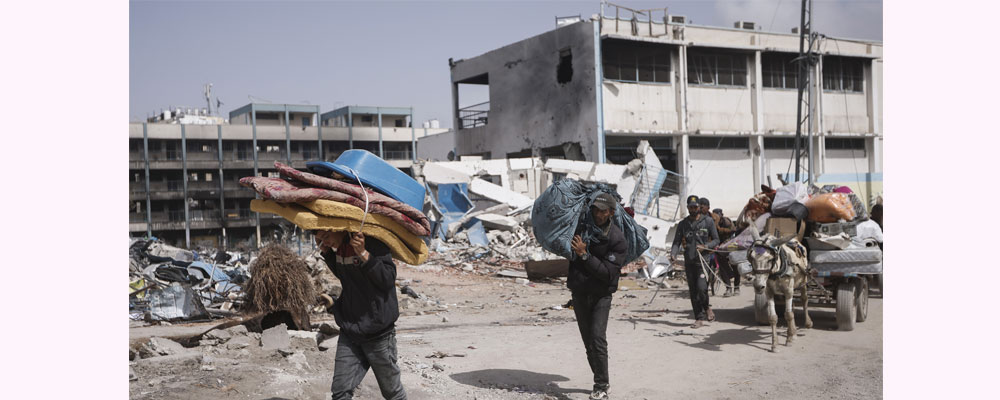The Biden administration’s delicate, much criticized line recognizes the lack of a coherent alternative strategy.

Since the start of the Israel-Hamas war, the Biden administration has tried to toe a delicate line: backing Israel’s war against the group in Gaza, while pushing Israel to ease the humanitarian toll of its operations and take the Palestinians’ legitimate political grievances seriously. By all accounts, toeing this line has been a frustrating and thankless endeavor—and, increasingly, a lonely one. Today, even the United States’ closest allies are calling for an “immediate ceasefire” that would put an end to Israel’s operations in Gaza. At home, the White House is facing increasing pressure from Democrats in the U.S. Congress and parts of the Democratic base to change its current tactics in dealing with Israel.
And yet, what the Biden administration understands—and what Israel’s many critics miss—is that the international community cannot dictate a solution to Israel-Hamas war by fiat. If the international community wants Israel to change strategies in Gaza, then it should offer a viable alternative strategy to Israel’s announced goal of destroying Hamas in the strip. And right now, that alternate strategy simply does not exist.
There is a brutal logic to Israel’s actions in Gaza. By its own estimates, Israel has destroyed three-quarters of Hamas’ battalions and killed two of five brigade commanders, 19 of 24 battalion commanders, more than 50 platoon leaders, and 12,000 of Hamas’ 30,000 foot soldiers. American intelligence estimates are lower, but not by much: Between 20 to 30 percent of Hamas’ fighters and 20 to 40 percent of its tunnels are estimated to have been destroyed as of mid-January. It’s also worth remembering that Hamas is structured more like a conventional military than a pure terrorist group. As a rule of thumb, conventional forces are considered combat ineffective once they lose more than 30 percent of their strength and destroyed once they lose 50 percent.
Even if Israel does not stamp out Hamas entirely but merely succeeds in driving it out of power and underground, from Israel’s view, that is still a win—even if stops well short of its goal of destroying the group, for doing so would likely prove sufficient to prevent Hamas from launching another 3,000-man complex assault like the one Israel saw on Oct. 7. Finally, it’s worth remembering that it took the United States several years to defeat the Islamic State. Israel is just over five months into what its leaders promised will be a very long war.
To be sure, there are serious drawbacks to the Israeli approach. This war will encourage long-term radicalization of the Palestinian population, damage Israel’s relationship with its Arab neighbors, and tarnish Israel’s global reputation in a pretty serious way. Yet all of these problems are long term. Too often, states and politics live in the here and now.
At the same time, Israel’s critics have failed—and continue to fail—to offer a coherent alternative way forward. Instead, more often than not, there are vague references for the need for some ill-defined “political solution” to the conflict. To the extent that there is a coherence to this alternate strategy, it revolves around using the threat of diplomatic isolation alongside economic threats that might force Israel to agree to an “immediate ceasefire.” That ceasefire, in turn, would pave the way for a longer-term political settlement, likely around a two-state solution. Problem solved. Or not.
For starters, international pressure and sanctions will not likely compel Israel to compromise. Israelis from the leadership on down are keenly aware that their country was born out of the ashes of Holocaust as a safe-haven for Jews after millennia of persecution. Israel then spent its first quarter-century fighting for its very existence. The idea that the world is aligned against Israel is deeply embedded in the nation’s collective DNA, and chants of “from the river to the sea,” coupled with surging global antisemitism, only ensure that those fears remain very much alive today.
Economic pressure—such as sanctioning settlers or restricting military aid—is unlikely to work, either. In general, sanctions have a poor track record of compelling states to abandon core national security interests. And given the Oct. 7 attacks, this war is nothing if not a core national security interest for Israel. Even if pressure did work initially, for a political solution to be sustainable, Israelis must voluntarily agree, not be pressured into it.
But let’s just say, for the sake of argument, that Israel caved to outside pressure and agreed to an immediate ceasefire. What would the day after look like? Hamas—as Israel and Hamas both acknowledge—would be left with a considerable military force, numbering in the thousands. Israel would then need to engage in another very lopsided deal to free the remaining hostages. In early February, Hamas wanted 1,500 prisoners freed from Israeli jails, including at least 500 serving life sentences for murder and other crimes, in exchange for the hostages.
So, at minimum, the group’s ranks would soon swell. And invariably, some of those released would be quite dangerous. After all, Yahya Sinwar—the head of Hamas in Gaza and alleged mastermind of the Oct. 7 attacks—was freed from an Israeli prison, where he was serving a life sentence for murder, in the 2011 trade of 1,027 prisoners for one captured Israeli soldier, Gilad Shalit. None of this recent history bodes particularly well for long-term peace.
In all likelihood, Israel would respond to a ceasefire by tightening its blockade of Gaza, citing Hamas’ continued existence as one reason for doing so. In particular, Israel would likely put severe limits on the quantities and types of building materials allowed into the Strip. After all, Hamas diverted an estimated 1,800 tons of steel and 6,000 tons of concrete to build its tunnel networks, and Israel would not want to see them rebuilt. The net consequence would be that desperately needed reconstruction would be severely delayed or even brought to standstill.



Washington must take creative and daring steps to mitigate human suffering and plant the seeds for a post-Hamas future.
The fighting would not stop, either. Fearing that Hamas will make good on its promise to repeat the Oct. 7 attack “again and again,” Israel would step up its preemptive strikes on Gaza and the West Bank, particularly whenever it got the first whiff that Hamas might be planning an attack. At the same time, Hamas would continue to attack Israel, if only to reinforce its legitimacy and divert attention away from the likely dismal conditions in Gaza (thanks, in no small part, to the stymied reconstruction effort). In all likelihood, the situation would be right back where it started.
Ah, but wait: Won’t a two-state solution solve this? Probably not. Even before Oct. 7, the majority of Israelis didn’t believe in a two-state solution, or that peace was even possible. There are likely even fewer who believe that now, especially if a Palestinian state were to include Hamas in some form. Consider how unfathomable it would have been for most Americans to support the creation of a state with al Qaeda at its helm just five months after 9/11. There is no reason to believe that the Israeli public should be any different. Given considerable support for Hamas among the Palestinian population, it would be politically impossible to exclude Hamas from a new, democratic Palestinian government. And even if the new state’s government is less than democratic, it would have trouble excluding Hamas entirely—even if it wanted to—if the group still has thousands of men under arms.
But even assuming that overwhelming international pressure forced Israel to agree to a two-state solution, it’s not going to guarantee peace in the short or medium term. There are still a host of thorny issues—including borders, water rights, air rights, the demilitarization of the Palestinian state, and the partition of Jerusalem—that would need to be resolved before a second state could come into being. Then there is the problem that only one-third of Palestinians favor a two-state solution themselves, and nine in 10 don’t trust the Palestinian Authority. For its part, Hamas has made it abundantly clear that it wants one state without Jews under an Islamist banner. None of this means that the international community shouldn’t push for a political settlement, but this is at best a long-term solution, not a near-term fix.
If a two-state solution did come about, it may not bring an end to hostilities. Two states did not solve hostilities between India and Pakistan, or North and South Korea, or North and South Vietnam. Israel would be under no obligation to grant Palestinians—now citizens of a separate country—workers’ permits, which would likely tank the nascent state’s economy, just as it wouldn’t have to provide electricity and other services to Gaza, as it did before the war. At the same time, Palestinians would rightly wonder why their state should be demilitarized and not entitled to the sovereign privileges of a “normal state.” There would perhaps still be Jewish settlers living on the territory of the new Palestine, creating all sorts of problems. Absent genuine buy-in from both sides, a two-state solution would simply turn a local conflict into an international one.
There is a lot to hate about Israel’s war in Gaza. It is a bloody, destructive war that has killed far too many innocents and upended far too many civilian lives. It is by any measure a human tragedy that will reverberate across the region for years to come. But if the international community is not simply grandstanding and actually hopes to solve the tragedy playing out in Gaza, then it needs to begin by offering feasible solutions that address both Palestinian grievances and Israeli security concerns.
To its credit, the Biden administration is at least trying to move in this direction. It is pushing Israel to curtail civilian casualties, set up safe zones, increase humanitarian aid, and move to a longer-term political solution—all while still backing (or at least not outwardly opposing) Israel’s ongoing operations to root out Hamas. Some might call such a balanced approach overly tactical and unable to quickly end the war, but a good strategy is built on sound tactics.
Unfortunately, the Biden administration’s nuance is the exception both internationally and in the domestic debate over U.S. policy. Just as the political right needs to be continuously reminded that the Palestinian population is not going anywhere and Israel cannot kill its way to victory, the political left needs to be reminded that Israelis are also not going anywhere and their equities must also be taken seriously.
Ultimately, if Biden’s critics on the political left want a different war, then they need to offer an alternative strategy and subject that strategy to the same sort of analytical rigor that it trains on Israel’s current military effort. If not, the brutal logic of the current war will remain, and the ongoing tragedy will continue.
Excerpts: Foreign Policy Magazine.
Raphael S. Cohenthe director of the Strategy and Doctrine Program at the Rand Corporation’s Project Air Force.




COMMENTS